Stitching Together an Ancient Story
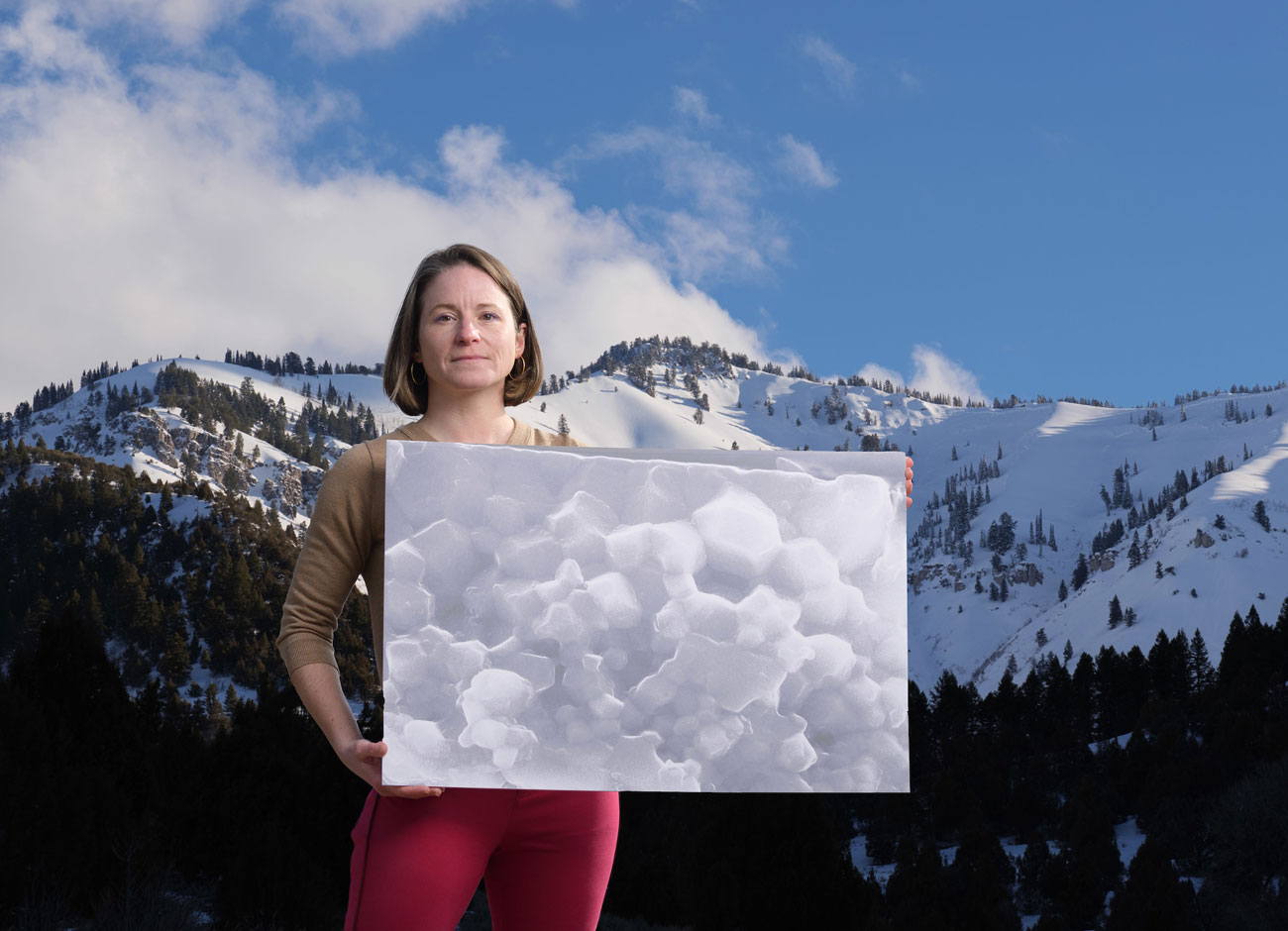
The machine hisses like a bike tube deflating.
“First we need to let the air out,” says Fen-Ann Shen, adjusting a valve on the scanning electron microscope (SEM) to create a vacuum inside. The 7,000-pound instrument parked in the basement of the Science Engineering Research building is worth more than many American homes.
With gloved hands, Shen, manager of Utah State University’s Core Microscopy Facility, plucks a sample from a shelf of gold nanoparticles on a carbon plate that resembles a typewriter key no longer in use. She tilts it forward and the disc flashes in the light.
“I am going to show you inside this,” she says.
The SEM uses a beam of electrons to scan the surface of samples down to the atomic level, revealing topography the human eye could never detect. The experience is akin to flying over farmland at 40,000 feet and seeing the latticework of roads and fields below.
“Our vision sees down to 100 microns,” Shen says, adjusting knobs for magnification and tuning the focus.
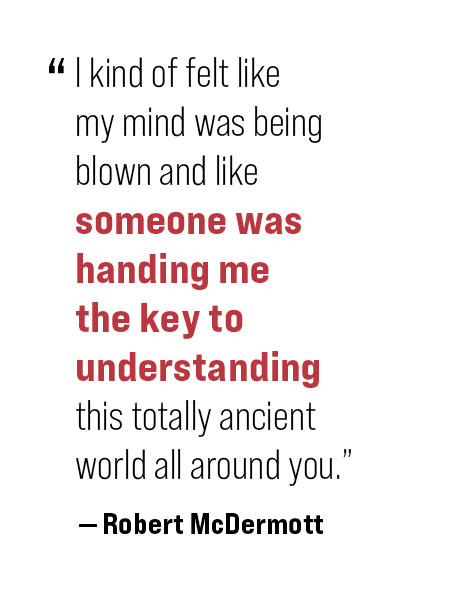
Fine details emerge showing the structure of the gold nanoparticles. At 200,000 times magnification, they look like pebbles on a beach, revealing how our eyes can be unreliable narrators of the world. Afterward Shen combs the shelf for a piece of hematite about a centimeter wide that shimmers like a shard from a mirror.
“This is Alexis’s,” she says. “From a small sample, she can discover a lot.”
Piecing Together a Story
The Alexis that Shen is referring to is Associate Professor of Geology Alexis Ault, a pioneer of new thermochronology tools she uses to study fault surfaces down to nanoscale and even atomic levels. Her work stitches together a fault’s earthquake history and the mechanisms of rock deformation, which can help scientists better understand geographic threats in a region.
The Wasatch Fault is about 240 miles long and active. And on March 18, 2020, a 5.7 magnitude earthquake in Magna, Utah, rattled buildings along the Wasatch Front, reminding residents of that fact, and causing upwards of $70 million in structural damage. Ault’s team doesn’t study modern earthquakes like these. They investigate the rock record of fault activity between 1 and 5 million years ago using thermochronology — the study of how rocks and minerals are shaped by temperature and time.
“If you can build a chronology of fault events, and you can backdate what the slip rate is on those events, you start to have a clearer picture of where we are heading,” she explains.
Ault’s team is looking for the bigger picture by starting with incredibly small details. They study the minerals coating fault surfaces, like hematite, a common iron oxide found in fault zones, to date earthquakes, as well as ascertain how shallow rocks in the subsurface may actually control how earthquakes stop.
When an earthquake occurs, part of what allows the surface to continue to slip are transformations on the fault surface, Ault explains. Sometimes material gets so hot or is so ground down that it becomes amorphous and loses its structure. Using the SEM, her team found textural and geochemical evidence that some amorphous slip surfaces quickly grow crystals, which may stabilize the material.
“What is so special about this mineral [hematite] is the textures that you can see with the scanning electron microscope give us clues about the conditions of when that mineral first formed,” Ault explains from her office. “It’s like its life story is in that texture.”
And it’s a story that takes time to uncover.
Finding Her Way
Alexis Ault wasn’t that kid with a rock collection. Geology was a course she took because it fulfilled a science requirement for her undergraduate education at Wellesley College. At the time Ault enrolled, she was lost. She comes from a family of physicians and initially thought she would be one, too. Ault switched to political science but was uncertain of her path. An introductory geology course shook something loose.
Faculty can be transformative for students, Ault says.
The professor kept her engaged and helped her gravitate towards something. She took another geology course and eventually worked with Meg Thompson, professor emerita of geosciences, who taught her to think like a scientist.
“Meg Thompson changed my life,” Ault says. “She bled over everything I wrote. She taught me how to write scientifically. It was these experiences that set me on my path.”
As an undergraduate, she was hired as the field assistant for another mentor, Rebecca Flowers, then an MIT doctoral student and now a professor of geological sciences at the University of Colorado Boulder. She traveled with Ault to remote Saskatchewan to collect samples of rocks nearly 2 billion years old.
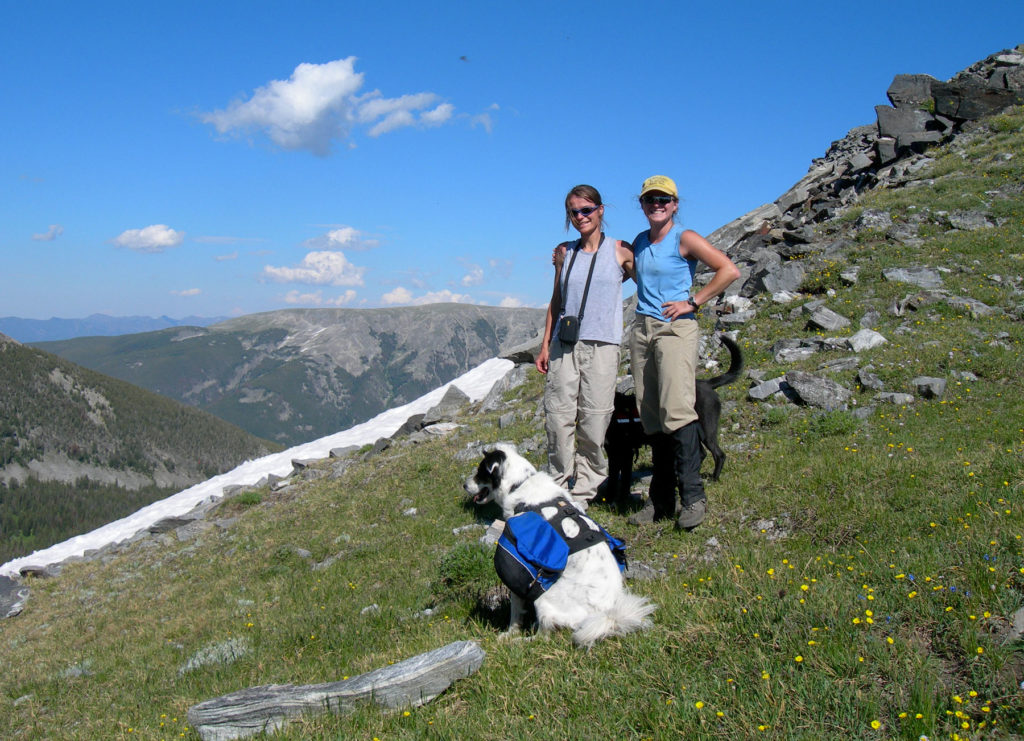
We were two women in the middle of nowhere Canada, moving around by float planes, Ault says, smiling. “I learned so much. I learned about geology. I learned how to build a Zodiac boat. I learned how to cook.”
Spending weeks together in the wilderness over two summers forged a friendship and mutual respect that led to Ault becoming Flowers’ first Ph.D. student at Boulder.
“Alexis, she is super enthusiastic, super inquisitive and curious, always upbeat, always excited about the geology and what’s coming next, always wanting to learn new things and integrate lots of information,” Flowers recalls. “I think those are part of who Alexis is, and you can sort of just see that all the way through her trajectory to where she is now, where she is still super excited and driving science in new directions.”
At the time, Flowers was exploring erosion histories across the interior of continents believed to be stable, she explains.
Ault specialized in a dating technique called uranium-thorium-helium that measures helium produced from the radioactive decay of trace amounts of uranium and thorium present in some fault rocks.
Alexis started to decipher these cryptic missing records using thermochronology, Flowers says, “and I think it was some of the first work of its kind that was exploiting these new advances in uranium-thorium-helium.”
While Flowers’ group continues work in this vein and develops different techniques to study deeper time histories, Alexis moved on to tackle different problems.
“You don’t want to just be a copy of your adviser,” Flowers says. “You want to grow into who you are as a scientist, and a person, and start your own projects, and start a whole new area of scientific research that other people follow you in. I think that is what Alexis is doing with all of her hematite work. She is doing, I think, really creative and innovative and groundbreaking work that she is really driving.”
At USU, Ault trained her focus on fault rocks closer to the surface, wondering what story they might tell through their textures. With support from a 2017 Faculty Early Career Development CAREER Award from the National Science Foundation (NSF), she is stitching that story together using uranium-thorium-helium dating along with new imaging techniques. She is also involving area middle school students in the process to ensure they know about where they live, and, maybe, who they can become.
Ault’s lab parses hematite collected from fault scarps near Brigham City, Utah, as well as from the southern portion of the San Andreas Fault in California. But why focus on this common iron oxide?
Hematite’s textures tell its story — not all minerals do that, Ault says. “Did it experience an earthquake? Did it just continue to creep [along a fault]?” she asks. “The most amazing thing, I think, is potentially because of the textures that developed when the mineral first formed, that sets the stage for how it continues to behave.”
Ault is the principal investigator of a 2021 NSF grant to study fault rocks along the southern San Andreas Fault to learn if there is something about them that promotes particular actions such as slow slip, which relieves pressure but doesn’t trigger earthquakes. Ault’s collaborations with experts in rock deformation will help build better hazard maps of active fault regions.
“For me, that is the kicker,” she says. “Is there something about the rocks that primes the pump to deform in a certain way? … At the end of the day, this matters because there is a very real need to understand the earthquake hazards in places like the Wasatch corridor … and along the San Andreas Fault. In seismically and tectonically active areas, the earthquake hazards to humans can be significant.”
Looking for Clarity
Eight years ago, the images Ault submitted with her work to a journal weren’t crisp. And the arguments she was making required clarity. Her paper was rejected, but an editor suggested she continue working on her ideas and gather better evidence.
Ault, a new faculty member at USU, contacted Fen-Ann Shen to use the SEM “as soon as possible,” she says. She likens the work to slicing a piece of cake — but using a beam of ions to shave a rock fragment so thin you can pass a beam of electrons through it.
Once her sample was under the SEM, Ault saw textures and grain morphologies that reminded her of polygonal grains present in quartz deformed 25 kilometers below the surface of the Earth. But her sample was from rocks gathered from much shallower depths.
This is the image I was seeing, Ault says, pointing to her laptop screen.
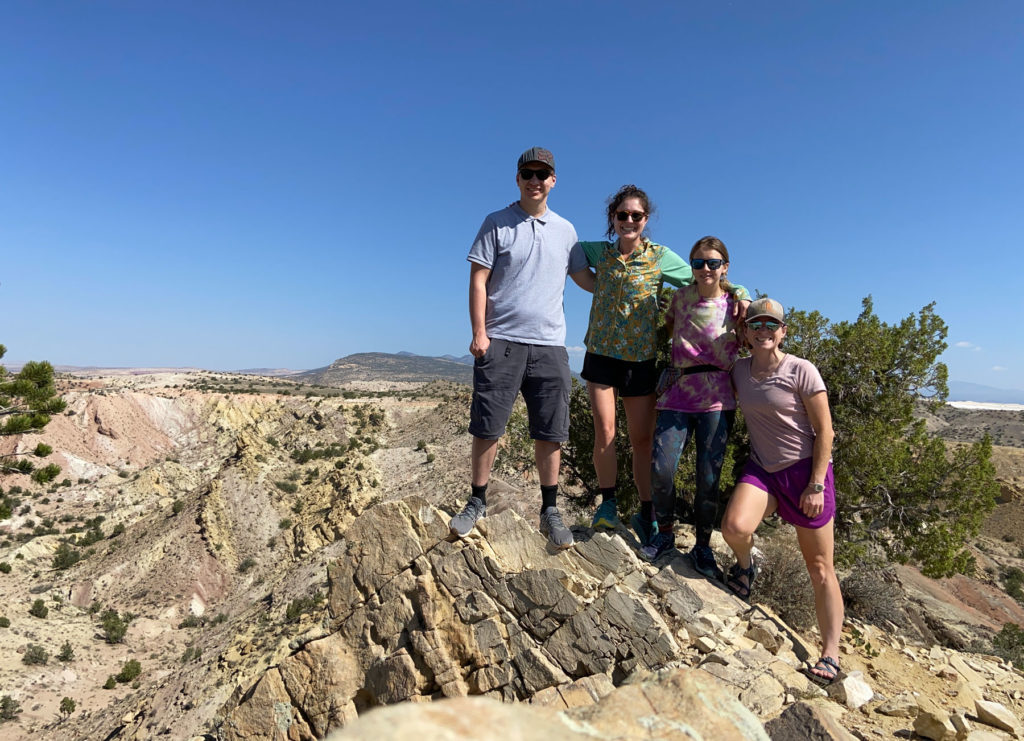
“Note these scale bars, this is nanometers,” she says. “You cannot see this with the old type of SEM. It takes this type of instrument. This is what I saw. And I was like ‘Oh my goodness. This is a sign of heat!’ And one way that you can have rocks get hot, if an earthquake has happened, is friction-generated heat.
“And that changed everything. That moment has changed everything.”
Ault’s office overlooks the Bear River Mountains, and her shelves display a mix of the geology department’s mineral samples she salvaged, rocks of various hefts she hauled back from her own field work, and posters from endurance mountain bike races she won. Ault doesn’t hide the fact that she wants to do well in everything she touches.
Her students notice that as well.
Robert McDermott Ph.D. ’20 was Ault’s first doctoral student at USU. Now a Mendenhall Postdoctoral Fellow at the U.S. Geological Survey in Alaska, he considers how to describe Ault.
“Her passion for what she does, it just really motivates you,” he says. “She pushes you, but part of it is just sort of inherent in the interactions with her, too. You come out of a meeting with her and you are jazzed to go do some science.”
Like Ault, McDermott stumbled into the field. But after his first class in college he realized that he enjoyed studying for the tests and found himself reading about geology in his spare time.
“I kind of felt like my mind was being blown and like someone was handing me the key to understanding this totally ancient world all around you,” he explains. “When I realized this is an academic pursuit, that I could be really happy doing this for a career, I’m constantly amazed at my luck.”
After listening to Ault at a conference, one of McDermott’s mentors suggested he apply to study faults with her.
“Nobody else was doing what she was doing,” McDermott says. “She was doing things that geologists had wanted to do for a long time, but in a new, unique way that was providing amazing insights. I recognized that and was like, ‘I want to do that too.’”
Meaningful Contributions
Madison Taylor ’19 has similar memories of working with Ault.
“She is such a hard worker, and she just has so much passion it is kind of impressive and intimidating, but in a good way,” Taylor says. “I think she does a great job at engaging her students and empowering them to conduct research for themselves.”
Taylor first met Ault in a geoscience communications course and was impressed by the in-depth comments she would leave in the margins. It was precisely what she wanted from a professor — feedback on how to improve.
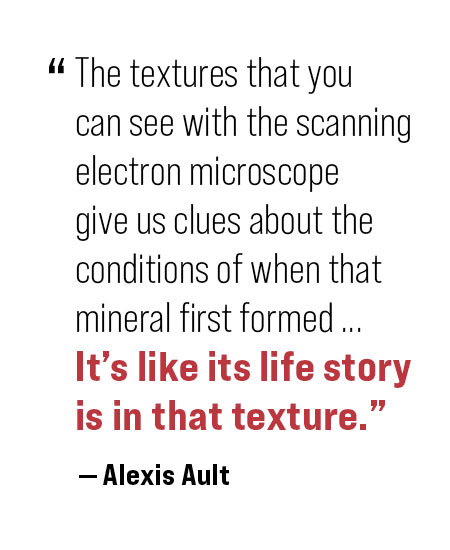
“My life is spent in track changes,” Ault laughs.
But she is serious, too.
Ault’s identity is forged through her work and encouraging her students to explore new terrain. She pushes them. And she praises them.
“She discovered textures that we have never seen before,” Ault smiles, recounting research Taylor conducted as a 2019 Peak Fellow at USU. She analyzed hematite samples from the Hurricane Fault to observe the textures and determine their cause and how to date those textures to learn more about the fault slip.
Taylor now works as a geologist for an environmental consulting firm in Washington and credits Ault for teaching her how to ask good questions.
“That is a really good way to learn more and engage on a deeper level,” she says.
These days, Ault finds herself asking new questions and partnering with experts from other disciplines to study hematite in natural faults and how it deforms in the lab under various conditions. It means moving into new territory. And, even for Ault, that can be hard.
“To make meaningful contributions to science, and to society in applying the tools that I am an expert in to fault rocks, I have to understand earthquake mechanics, all of these things that are new for me,” she admits. “This is not my training. And that is exciting, but also an intimidating space.”
She pauses before carefully continuing.
“My job is everything to me, and I try and get it right and to teach my students to get it right,” Ault says. “I do push them. But I am learning right alongside them.”
By Kristen Munson
Opening photo by Casey McFarland.
Caption: Alexis Ault, associate professor of geology, shows the microcrystalline texture of hematite that formed when a fault moved. It’s only visible with a scanning electron microscope.






